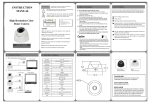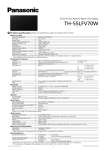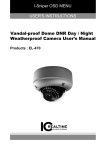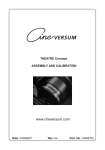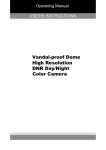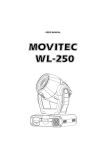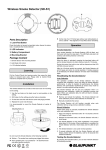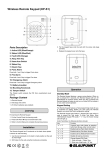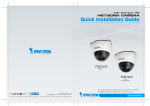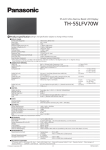Download HD-S1 User Manual
Transcript
Wireless Heat Detector (HD-S1) Parts Description 1. LED Indicator Press the button to transmit a learn/test code, silence the alarm or test the Heat Detector 2. Learn/Test Button 3. Battery Compartment 4. Mounting Bracket Package Content 1 x Heat Detector 4 x wall plugs and screws 3 x 1.5V AA alkaline batteries 1 x Mounting Bracket Learning Put the Control Panel into learning mode, then press the Test Button to transmit learn code, the Heat Detector will emit a two-tone beep. Refer to your Control Panel manual to complete learning process. Operation Temperature Detection The Heat Detector monitors temperature condition and will raise alarm when either of the following conditions are met: 1. When temperature exceeds 57.3°C. 2. When temperature rises more than 8.3 °C per minute. The Heat Detector will then send alarm signal to Control Panel and raise alarm with its built-in siren. The LED will flash rapidly. After activation, the Heat Detector will check the temperature every 10 seconds and continue to sound alarm until either of the following conditions is met: 1. If temperature has exceeded 57.3°C, the temperature must drop below 49°C for alarm to stop. 2. If the temperature did not exceed 57.3°C and the alarm is triggered by temperature rising more than 8.3 °C per minute, the temperature must drop 4°C below the highest temperature for alarm to stop. When either of the above condition is met, the Heat Detector will stop alarming and send a restore signal to the Control Panel. If the alarm is not stopped, the Heat Detector will resend the alarm signal every 2 minutes. You can stop the alarm manually by pressing the learn/test button to enter Alarm Silence mode. Installation Alarm Silence When the alarm is activated, pressing the Test button will put the Heat Detector into Alarm Silence mode for 10 minutes. Mounting The Heat Detector has 2 knockouts on the mounting bracket for mounting on the ceiling. 1. Use the two knockouts on the back cover to mark position on the ceiling. 2. Drill holes into the ceilling using the knockouts as template. 3. Fix the mounting bracket onto the wall with the screw and plugs provided. 4. Line up the Heat Detector with the hook on the bracket. Fit the hooks into the two mounting holes on the, rotate the Heat Detector counter-clockwise to lock it in onto the bracket. Knockouts x 2 During this period, the built-in siren will be stopped and the LED will flash once per second. After the 10-minute period is over, the Heat Detector will sound a 2-tone beep and return to normal operation. If the temperature is still over alarm threshold, the Heat Detector will sound the warning alarm again. Testing the Heat Detector You can test whether the Heat Detector’s temperature sensor is functioning normally by pressing the learn/test button once under normal operation LED Indicator Off Normal Operation On (2 seconds) The Heat Detector is sending an alarm signal Quick Flash The Heat Detector is alarming Flash second every Flash every seconds 30 During Alarm Silence mode, the LED will flash once every second for 10 minutes. Low Battery Flash every 60 seconds with one beep. The Heat Detector is out of order or low on battery On (1.5 seconds) When the learn/test button is pressed under normal operation Battery The Heat Detector uses three 1.5V AA alkaline batteries as its power source. It also features low battery detection function to notify the Control Panel when battery voltage is low. When Heat Detector is on low battery, follow the procedure below to change the batteries. 1. Rotate the Heat Detector clockwise to remove it removed from the mounting bracket. 2. Remove the battery compartment cover. 3. Remove the old batteries. 4. Press the learn/test Button several times to fully discharge. 5. Insert the new batteries and orient them according to the correct polarity. The Heat Detector will sound a two-tone beep. 6. Replace the battery compartment cover. 7. Hook the Heat Detector back to the mounting bracket Specification Environmental Condition -10°C to 40°C, relative humidity 85% non-condensing. Radio 433 MHz FCC Statement This device complies with Part 15 of the FCC Rules. Operation is subject to the following two conditions: (1) This device may not cause harmful interference, and (2) This device must accept any interference received, including interference that may cause undesired operation. FCC Caution: To assure continued compliance, any changes or modifications not expressly approved by the party responsible for compliance may void the user's authority to operate this equipment. (Example - use only shielded interface cables when connecting to computer or peripheral devices).


